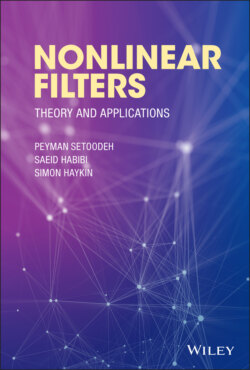Читать книгу Nonlinear Filters - Simon Haykin - Страница 15
2.2 State‐Space Model
ОглавлениеThe behavioral approach for studying dynamic systems is based on an abstract model of the system of interest, which determines the relationship between its input and output. In this abstract model, the input of the system, denoted by , represents the effect of the external events on the system, and its output, denoted by , represents any change it causes to the surrounding environment. The output can be directly measured [10]. State of the system, denoted by , is defined as the minimum amount of information required at each time instant to uniquely determine the future behavior of the system provided that we know inputs to the system as well as the system's parameters. Parameter values reflect the underlying physical characteristics based on which the model of the system was built [9]. State variables may not be directly accessible for measurement; hence, the reason for calling them hidden or latent variables. Regarding the abstract nature of the state variables, they may not even represent physical quantities. However, these variables help us to improve a model's ability to capture the causal structure of the system under study [11].
A state‐space model includes the corresponding mappings from input to state and from state to output. This model also describes evolution of the system's state over time [12]. In other words, any state‐space model has three constituents [8]:
A prior, , which is associated with the initial state .
A state‐transition function, .
An observation function, .
For controlled systems, the state‐transition function depends on control inputs as well. To be able to model active perception (sensing), the observation function must be allowed to depend on inputs too.
The state‐space representation is based on the assumption that the model is a first‐order Markov process, which means that value of the state vector at cycle depends only on its value at cycle , but not on its values in previous cycles. In other words, the state vector at cycle contains all the information about the system from the initial cycle till cycle . In a sense, the concept of state inherently represents the memory of the system [13]. The first‐order Markov‐model assumption can be shown mathematically as follows:
(2.1)
It should be noted that if a model is not a first‐order Markov process, it would be possible to build a corresponding first‐order Markov model based on an augmented state vector, which includes the state vector at current cycle as well as the state vectors in previous cycles. The order of the Markov process determines that the state vectors from how many previous cycles must be included in the augmented state vector. For instance, if the system is an th‐order Markov process with state vector , the corresponding first‐order Markov model is built based on the augmented state vector:
(2.2)
Moreover, if model parameters are time‐varying, they can be treated as random variables by including them in the augmented state vector as well.
